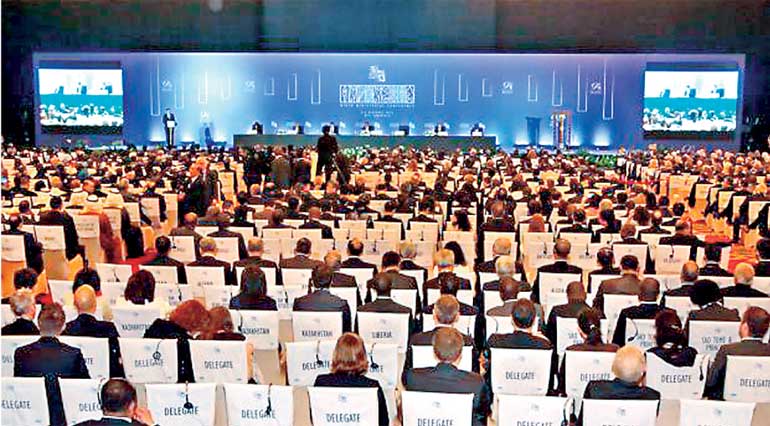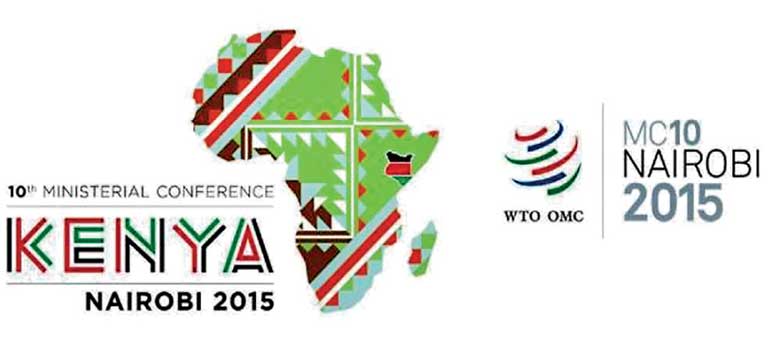Monday Dec 08, 2025
Monday Dec 08, 2025
Tuesday, 15 December 2015 00:09 - - {{hitsCtrl.values.hits}}
The 10th Ministerial Conference of the WTO will take place in Nairobi, Kenya during 15-18 December 2015. This is the first time that a WTO Ministerial is taking place in Africa and many developing countriesare looking forward with expectations as well as with apprehensions on the outcome of Nairobi

WTO-Bali Outcome
WTO functioned without any breakthrough in the Doha Development Agenda (DDA agreed in 2001) until the 9th Ministerial Conference in Bali in 2013. The breakthrough achieved in Bali put WTO back on track as a credible multilateral trading system.
The binding multilateral Trade Facilitation Agreement (TFA) of Bali was considered a major breakthrough and it contained provisions for expediting the movement, release and clearance of goods, including goods in transit. It also outlinedmeasures for effective cooperation between Customs and other appropriate authorities on trade facilitation and Customs compliance issues. It further contained provisions for technical assistance and capacity building in this area.
Some have argued that the major beneficiaries of this Agreement will be the developed countries who will have better market access for developing country markets. Most developed countries already have trade facilitation procedures in place whereas developing countries will have to make legislative changes and mobilize funds to put the new TFAinto effect within the stipulated time period of 10 years.
In theBali package, the other two main items -- agriculture and development issues -- were legally non-binding. In agriculture, there were three key items, viz., (a) public stock holding for food security (mainly pushed by India); (b) understanding on tariff rate quota administration and export competition; and (c ) trade-distorting subsidies for cotton (to assist cotton farmers in Africa by removing these subsidies in US as agreed in WTO-Hong Kong–2005 declaration). Under development issues there were four key items; viz., (1) preferential rules of origin for the poorest countries, (2) duty-free and quota-free full market access for LDCs (Least Developed Countries); (3) waiver for services of LDCs; and (4) monitoring mechanism on Special and Differential Treatment.
The WTO Post- Bali Work Programme and the Unfinished Agenda
The Bali declaration stated that: “The Work Program will be developed in a way that is consistent with the guidance we provided at the Eighth Ministerial Conference, including the need to look at ways that may allow members to overcome the most critical and fundamental stumbling blocks”.
On the DDA, the Bali declaration states: “We instruct the Trade Negotiations Committee to prepare within the next 12 months a clearly defined Work Program on the remaining Doha Development Agenda. This will build on the decisions taken at the Ministerial Conference, particularly on agriculture, development and LDC issues, as well as other issues under the Doha mandate that are central to concluding the Round. Issues in the Bali package where legally binding outcomes could not be achieved will be prioritized. Work on issues in the package that have not been fully addressed at this Conference will resume in the relevant Committees or Negotiating groups of the WTO”.

There is a wide gap between this declaration and the actual outcome during the last 12 months. First, the TFA will enter into force once two-thirds of the WTO membership has formally accepted the Agreement; however, only 51 out of the 162 members of the WTO have ratified the agreement so far. No doubt there is some progress on this Agreement, however, it is slow.
Progress under the agriculture development issue has been almost nil.After Narendra Modi became Prime Minister of India,he took strong exception to the four year peace clause agenda for public food stock holding at the Bali Ministerial under which developing countries cannot be legally challenged if they breach the WTO ceiling on public stockholding for food security purposes. Modi threatened to stall the TFA and pressurized developed countries led by the USA to change the Bali Agreement to include a permanent peace clause for developing countries. Although it was agreed in Bali to ‘engage constructively’ for a permanent solution on the issue by 2015, there has been hardly any progress. Indian Commerce Minister, Nirmala Sitaraman criticized developed countries for not agreeing to a post-Bali work plan for many of the decisions taken, including a permanent solution on food security.
There has not been much progress on any of the non-binding issues on the development dimension either. For instance, the waiver for services has manifested as developed countries offering the same unilateral commitments on services made at the WTO to LDCs. All items under the development issues are presented under the best endeavour clause and usually the developed countries dismiss them after the declaration, although there was an agreement to monitor the implementation of Special and Differential Treatment.
By-Passing the WTO-DDA
Developed countries are of the view that after years of stalemate under the DDA framework, it is very unlikely that any further progress will be made under it. In the face of the DDA deadlock, the developed countries have taken initiatives to advance trade liberalization outside the WTO framework through, for instance, plurilateral arrangements and mega-regionals.
Plurilaterals
The developed countries are of the view that if consensus cannot be reached among all WTO members, there is nothing that prevents willing members to form a coalition and move forward and reach an agreement among themselves on selected issues. The plulilateral negotiations on the Information Technology Agreement (ITA) and Government Procurement Agreement have emerged in the WTO on these lines. The assumption is that the benefits of these agreements will be extended to non-members on Most  Favoured Nation (MFN) basis and thereby they will strengthen the multilateral trading system.
Favoured Nation (MFN) basis and thereby they will strengthen the multilateral trading system.
Negotiations under this approach is currently taking place in services with the Trade in Services Agreement (TISA) led by US and Australia and this group accounts for 70 per cent of world trade in services. Since January 2014, a group of 14 countries accounting for 86 per cent of global trade in environment goods arenegotiating for an agreement in the sector.
Developing countries oppose the plurilateral approach because these agreements tend to be exclusive and they de facto remove certain sectors from the DDA negotiations. This in turn,reduces the opportunities for bargaining trade-offs with areas of interest to developing countries, such as food security and livelihoods. In other words, pluritaerals are seen as a method of further marginalizing developing countries in global trade and developed countries by-passing the dialogue on development issues. Moreover, it is seen as a device to introduce global two track trading and thereby marginalizing the developing countries.
Mega – Regionals
The emergence of mega-regionals such as TPP (Trans Pacific Partnership) and Transatlantic Trade and Investment Partnership (TTIP), both led by the US, are a means to by-pass the WTO and impose a rule-based trading system for a selected group of countries. TPP accounts for 40 per cent of global GDP, 26 per cent of global exports and imports, and 44 per cent of global FDI outflows. While economics drive the TPP, there is also politics in terms of containing China and excluding Russia.
TPP in particular aims for high standards and all members have to agree to comply with them to secure duty free (or low tariff) market access to member countries. Consequently, a TPP member like Vietnam will obtain duty free market access to US in products like ready-made garments which will be a threat to a competing non-member on the US market such as Sri Lanka. This is a major challenge in the emerging global trading environment and the WTO offers no solutions to such arrangements.
Possible Way Out of the WTO DDA Stasis
There are two perspectives on this, one put forward by some trade negotiators in the WTO and the other by developed countries. Some trade negotiators propose to make a departure from the ‘single undertaking’ clause of the WTO like in Bali and adopt a piecemeal approach which would be incremental on the basis of acceptability and practicality, while some developed countries argue to adopt the plurilateral agreements and request non-members to the agreement to join the plurilaterals when they are ready.
There are problems in both these suggestions.The Bali type of method of tapping the ‘low hanging fruits’ by a smaller package needs to be worked out containing elements from agriculture, NAMA (Non-Agricultural Market Access), services, development issues, and the rest. The challenge is to carve out the right balance in the package which is acceptable to all WTO members. However, this approach will also need to take the current realities of the global economy into account such as the rise of emerging economies, spread of the global value chains, issues of exchange rate management, the emergence of ‘mega regionals’ like TPP, etc. -- and in the absence of WTO rules and regulations in such new areas, how they could be incorporated remains a challenge. In regard to plurilaterals, questions have been raised as to how these agreements can be a part of a multilateral framework like WTO ? If they are going to be incorporated in the WTO on the basis that the benefits are extended on an MFN basis, how many developing countries will be prepared to take them on board ?
Whichever way one approaches the problem, it is essential to address the core issues of the DDA which have been in the ‘deep freezer’ since 2008. Moreover, the world has changed during the past seven years and there is a need to look at the 2008 negotiating text from the contemporary perspective.
The Nairobi Outcome
On 27th November 2015 the draft declaration for the Nairobi Ministerial was presented and it is divided into three parts. Part 1 is basically a preamble on WTO’s achievements and challenges it faced during the past 20 years. Part 2 contains the decisions that will be adopted at the session, viz., TRIPS Non-violation and Situation Complaints, Work Program of E-Commerce, and Work Program on Small Economies, and Part 3 provides the concluding remarks. According to CUTS International(10th Ministerial Conference in Nairobi – What’s on the Table ?), the language in Part 3 is pessimistic compared to that of the Bali Declaration where it states: “regret that it has not been possible to reach agreement on all areas of negotiations”. This statement amply reflects that there isunfinished business from the Bali agenda and no clear process to bring the DDA to a closure.
Three scenarios are possible from the 10th Ministerial Conference in Nairobi: (a) DDA-minus; (b) New Round of Trade Negotiations; and (c) Drag the status quo with the DDA with a post-Nairobi work plan. Most developed countries will push for either (a) or (b) with more preference to (b). Scenario (a) is basically equivalent to burying the DDA and moving away from mainstreaming trade to the development agendas of developing countries and market access becoming the key in global trading. It is unlikely that the G-77 and the emerging economies like India, China, and Brazil will permit this to happen, as 80 per cent of the DDA has already been agreed upon and the stalemate is only for the remaining 20 per cent of the agenda items as once stated by Pascal Lamy, the former Director General of the WTO.
Scenario (b) amounts to abandoning the remaining items in the DDA and moving into new issueslike Global Value Chains, again which the developing countries will resist as they did far back as in the Singapore Ministerial in1996 where the introduction of four new issues to the WTO agenda was prevented until implementing issues were settled. A similar reaction from developing countries is likely if scenario (b) is pursued in Nairobi.
Given these positions, the most likely outcome from Nairobi is the status-quo continuing with a post-Nairobi work program – dragging the DDA further with very little outcome. The WTO website indicates that since the stasis of the WTO, the number of RTAs has increased to nearly 413 by 2015. Clearly, the integration of developing economies to the global economy is taking place more by regional and bilateral freetrade agreements (RTAs and FTAs) rather than the multilateral trading system defined by the WTO. This then will be the way forward for trading for developing countries, i.e., while being token members of the WTO and engaging in multilateral trading, working out FTAs and RTAs with willing trading partners and engaging in ruled-based preferential global trading with them.All indications are that global trading will get fragmented and the WTO will gradually become a weak institution in governing 21st century international trading.
The writer is the Executive Director of the Institute of Policy Studies of Sri Lanka